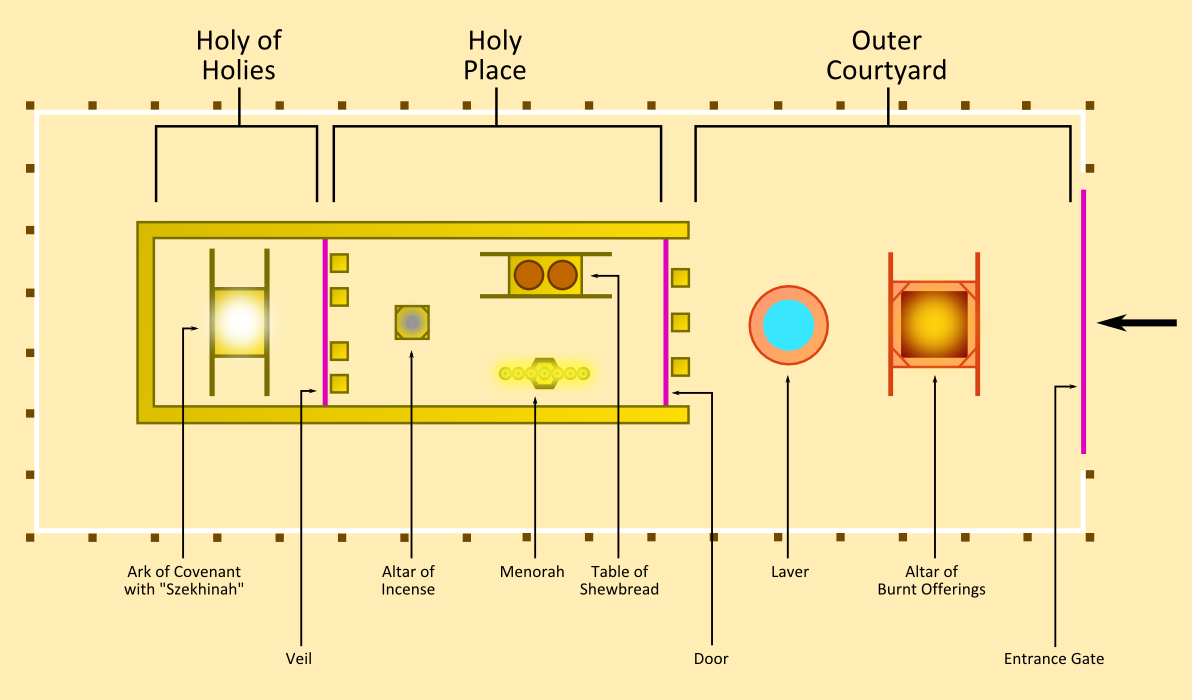Tabernacle of Moses
Early in my prayer journey, I discovered a wonderful model for prayer in The Threshing Floor by Juanita Bynum. Using the Tabernacle of Moses, she describes how to come into the presence of the Lord through prayer.
It makes so much sense! Did you know that the Tabernacle was given to Moses to help the Israelites come into God’s presence as they were wandering through the wilderness? The Tabernacle was a place where God dwelt among His people.
This same tabernacle model of prayer is a key to how we can have a deep and abiding experience of the Holy Spirit. Like the tabernacle, Jesus is our way into knowing and understanding the heart of God.
Three Parts of the Tabernacle
The Tabernacle was composed of three areas: the outer court, the Holy Place, and the Holy of Holies. Within each area were pieces of furniture with specific functions. The design and function of each element helped the Israelites and priests draw closer to Him. Likewise, each element of the Tabernacle shows us how to draw closer to Jesus Christ and seek His presence as we pray.
 Attribute: By Adik86 (Own work) [GFDL (http://www.gnu.org/copyleft/fdl.html) or CC-BY-SA-3.0 (http://creativecommons.org/licenses/by-sa/3.0)], Wikimedia Commons
Attribute: By Adik86 (Own work) [GFDL (http://www.gnu.org/copyleft/fdl.html) or CC-BY-SA-3.0 (http://creativecommons.org/licenses/by-sa/3.0)], Wikimedia Commons
The Gate: The gate was the entry into the outer court. For us, Jesus is the gate into the outer court. When we accept Jesus as our Lord and Savior we pass through this gate and begin our relationship with the Father, Son, and Holy Spirit. Jesus is the one and only path into the presence of God.
Outer court: Anyone who receives Jesus Christ can enter through the gate into the outer court of the Tabernacle. The outer court is a place of repentance and cleansing as we “burn up” and “wash away” anything that interferes in our relationship with Jesus. The Brazen Altar and the Brazen Laver were located in the outer court.
- Brazen Altar (Altar of Burnt Offerings). The priests sacrificed animals to atone for the people’s sins at the brazen altar. Under the new covenant, the altar represents Christ’s sacrifice on the cross. In prayer, we repent and die to self by giving up our own desires and seeking His will.
- Brazen Laver. The priests washed their hands and feet at the large basin known as the brazen laver. After we repent of our sins, we are washed by the blood of Jesus and cleansed of all our sins. We are changed and sanctified.
As we pray, we symbolically move through the outer court – repenting of our sins, asking and receiving forgiveness for our daily sins, and experiencing refreshment – as we seek intimacy with God. Just remember to not tarry too long in the outer court! Jesus intends for us to freely accept His unconditional love.
Holy Place: The Holy Place symbolizes deeper intimacy with Jesus. Three pieces of furniture were contained within this space: Table of Shewbread, Golden Lampstand, and Altar of Incense.
- Table of Shewbread: This was the table where the priest placed 12 special loaves of bread to represent the 12 tribes of Israel. This bread represents the Word of God, our bread of life. We are to partake of and be filled up by God’s Word, particularly in prayer. It is to be our guiding light.
- Golden Lampstand (Menorah): The seven oil lamps on the Golden Lampstand provided light in the Holy Place. For us, the lampstand represents the light of the Holy Spirit. The Holy Spirit gives us divine understanding of the Word and greater ability to discern the deeper things of God as we pray.
- Altar of Incense: The priests burned an offering of incense morning and evening. It is here that we worship, prayer, and intercede on the behalf of others as we hear and respond to God’s voice. Our prayers become a pleasing aroma to God, like incense.
Holy of Holies: A small, separate room called the Holy of Holies was located inside the Holy Place. It was here that the Ark of the Covenant – a golden box that contained all the symbols of God’s covenant with Israel – was kept. The Holy of Holies was God’s special dwelling place that could only be entered by the High Priest once yearly to offer a sacrifice for people’s sins.
Here we meet with God and sit in His presence. His spirit speaks to our spirit, we hear his voice, we have dreams and visions, and we respond in prayer. We have our most intimate times with Him in our symbolic Holy of Holies.
How to Use the Tabernacle as a Model for Prayer
Experiment with the tabernacle as a prayer model. Visualize yourself moving from the outer court into the inner court and then into the Holy of Holies. Symbolically perform the functions described above and summarized below at each piece of furniture.
- Repent and offer yourself as a living sacrifice at the Brazen Altar.
- Cleanse yourself and receive forgiveness through Jesus Christ at the Brazen Laver.
- Nourish yourself with the Word of God at the Table of Shewbread.
- Let the Holy Spirit fill you with truth and new revelation as you meditate on the Word at the Golden Lampstand.
- Offer up continuous praise, worship, and prayer as you seek the manifest presence of God at the Altar of Incense.
- Enter into God’s presence as you encounter His spirit in the Holy of Holies.
Try doing this daily during your quiet time. Discover how this act of preparation draws you deeper in your relationship with Jesus. Wrap yourself in His presence and joy!
Also, discover the result of praying for your community in this blog post. Praying in community changed my life!